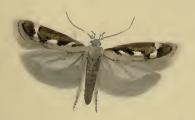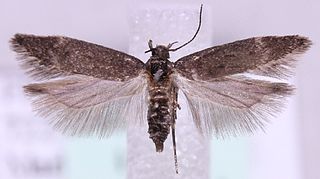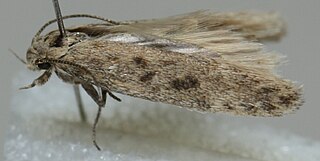
Recurvaria leucatella is a moth of the family Gelechiidae. It is found in most of Europe, Turkey, Central Asia and the Caucasus.

The lobster-clawed moth is a moth of the family Gelechiidae. It is found in most of Europe, except for the Iberian Peninsula and most of the Balkan Peninsula. In the east, the range extends to Siberia and Taiwan.

Monochroa cytisella is a moth of the family Gelechiidae and found in most of Europe. The larva feed in the stems of bracken causing a slight gall.

Caryocolum marmorea is a moth of the family Gelechiidae. It is found from Scandinavia to the Mediterranean islands, and from Ireland to Poland, Hungary and Greece. It is also found on the Canary Islands and Madeira. It is also found in North America.

Caryocolum viscariella is a moth of the family Gelechiidae. It is found in Ireland, Great Britain, Fennoscandia, Denmark, Germany, France, Switzerland, Austria, Hungary, Italy, Estonia and Russia.

Aproaerema anthyllidella is a moth of the family Gelechiidae. It is found in most of Europe, Kyrgyzstan, Iran and North America.

Apodia bifractella is a moth of the family Gelechiidae. It is found in most of Europe, as well as Turkey, the Caucasus and North Africa.

Bryotropha similis is a moth of the family Gelechiidae. It has a Holarctic distribution, including Greenland and Iceland. It is widespread in northern, central and eastern Europe. In southern Europe, it is only known from a few mountainous regions. It is also found throughout the Palaearctic.

Bryotropha senectella is a moth of the family Gelechiidae. It is found throughout Europe.
Monochroa suffusella, the notch wing neb, is a moth of the family Gelechiidae. It is found from Fennoscandia to the Pyrenees and Alps and from Ireland to Romania. In the east, the range extends to Japan. The habitat consists of bogs, fens, swamps and salt-marshes.

Chionodes distinctella, the eastern groundling, is a moth of the family Gelechiidae. It is found in almost all of Europe, as well as most of Russia, Kazakhstan, Central Asia and North Africa. The habitat consists of dry, rocky heath and meadows and the verges and rough pastures.

Ptocheuusa paupella, the light fleabane neb, is a moth of the family Gelechiidae. It is found from central and southern Europe to the Ural Mountains. It is also found in Turkey and India.

Monochroa lutulentella, the black neb, is a moth of the family Gelechiidae. It is widely distributed in northern Europe and the central European mountains, east to the Ural Mountains. The habitat consists of fens, marshes and on river-banks.

Teleiodes luculella, the crescent groundling, is a moth of the family Gelechiidae. It is found from Europe to the southern Ural and Transcaucasia. The habitat consists of woodlands, including oak woodlands.

Gelechia rhombella, the apple groundling, is a moth of the family Gelechiidae. It is found in Europe, the Caucasus, Transcaucasia, southern Siberia, the Russian Far East, Korea and China.

Scrobipalpa atriplicella, the goosefoot groundling moth, is a moth of the family Gelechiidae. It is found from most of Europe throughout Asia to Kamchatka and Japan. It is an introduced species in North America.

Scrobipalpa obsoletella, the summer groundling, is a moth of the family Gelechiidae. It is found in most of Europe, Turkey, the Caucasus, from Iran to Asian Russia (Transbaikal) and Mongolia. It has also been recorded from New Zealand, South Africa and North America, where it is probably an introduced species. The habitat consists of coastal salt marshes and sandy beaches.

Scrobipalpa samadensis, the buck's-horn groundling, is a moth of the family Gelechiidae. It is found in most of Europe and Russia.

Syncopacma sangiella, the brown sober, is a moth of the family Gelechiidae. It was described by Henry Tibbats Stainton in 1863. It is found in most of Europe, except the Benelux, Denmark and parts of the Balkan Peninsula.

Eulamprotes atrella, the two-spotted neb, is a moth of the family Gelechiidae. It was described by Michael Denis and Ignaz Schiffermüller in 1775. It is found from most of Europe, east to Japan. The habitat consists of mixed deciduous woodlands.

















